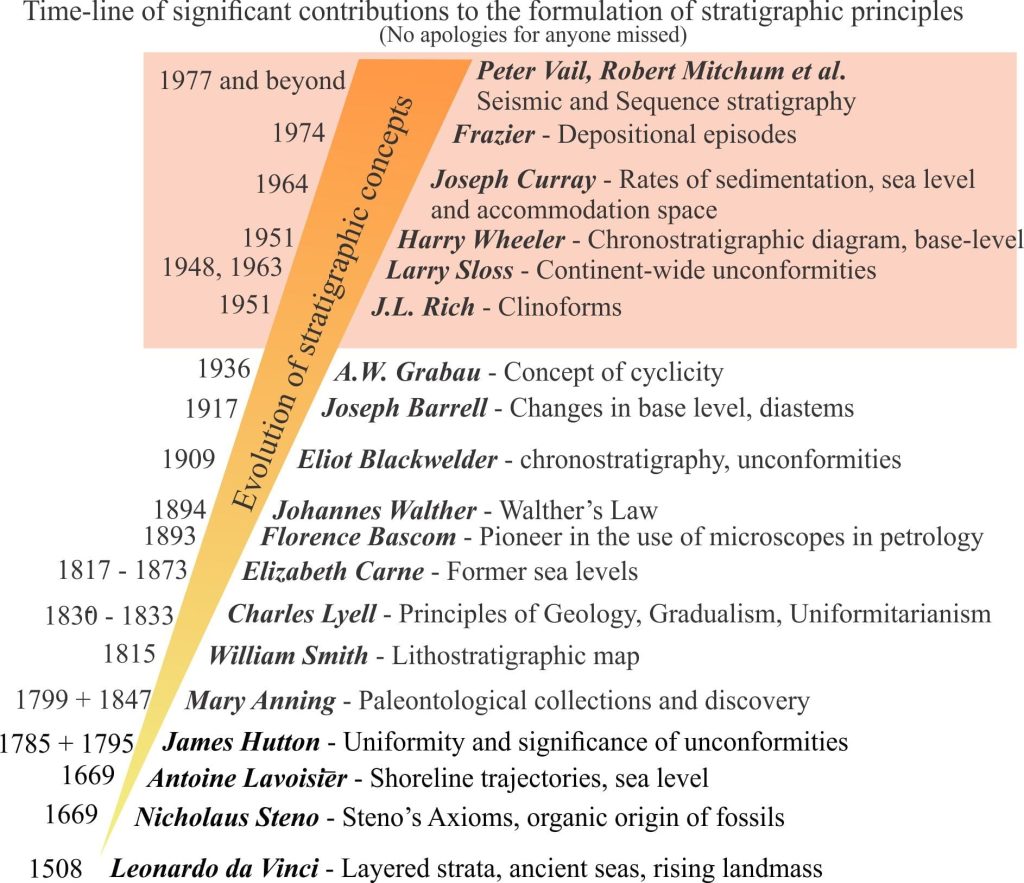
This is the third of three posts that look briefly at the development of stratigraphic concepts and the people responsible for them, spanning 1950 to 1977. This period witnessed the maturing of modern stratigraphic concepts from formal, descriptive lithostratigraphy to less formal genetic stratigraphy that was more concerned with depositional processes and time, particularly the recognition of chronostratigraphic surfaces.
This is part of the How To…series on Stratigraphy and Sequence Stratigraphy
Preamble: My intent was to write a single post on this topic, as an introduction to Stratigraphy in general, and Sequence Stratigraphy in particular. But I kept adding names to the timeline, and got carried away with some of the characters on it. So the number of posts was expanded.
John Rich (1884-1956)
John Rich was another all rounder, publishing widely on sedimentology and stratigraphy, with excursions into submarine canyons and shelf to basin facies transitions. It was his examination of the latter, combined with ocean floor geomorphology, that led him to propose the concept of clinoforms, geometric components that are a critical element of modern sequence stratigraphy. He defined a clinoform as a sinusoidal surface extending across the shelf from wave base to the base if the adjacent slope. Shoreward of wave base is the undaform; beyond the base of slope is the fondoform. (Rich, 1951) Together they represent a time, or chronostratigraphic surface. Based on modern analogues of shelf, slope and deep basin, he identified prominent sedimentary facies and depositional processes that could be used to identify and interpret similar arrangements in the rock record.
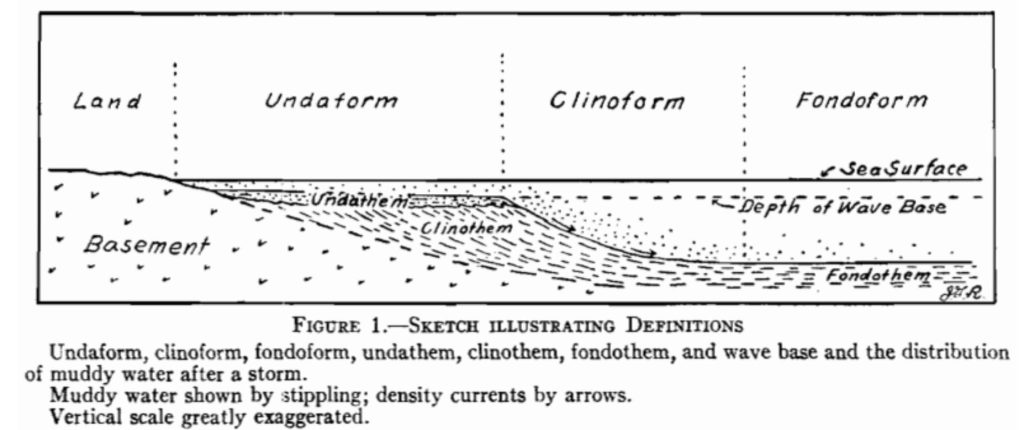
The terms undaform and fondoform have all but faded into obscurity; these days, all are generally referred to as clinoforms, and their stratigraphic representation as clinothems. The term clinoform is no longer restricted to shelf-slope morphologies, and can be used at almost any scale (Patruno, W. Helland-Hansen, 2018). For example, topset, foreset and bottomset beds of fan deltas are typically bound by clinoforms.
Rich’s use of wave base is also important; it is the depth limit at which waves and wave orbitals cease to move sediment across the sea floor. It represents a significant boundary between inshore and deeper shelf sedimentation; we now use it to define the outer limit of the shoreface. He surmised that during sea level fall, undaform sands, particularly those across a beach, would move seawards in concert with wave base, a process that might continue to the shelf margin – we can almost hear him thinking shelf margin, or forced regressive sand clinoforms.
Larry Sloss (1913-1996)
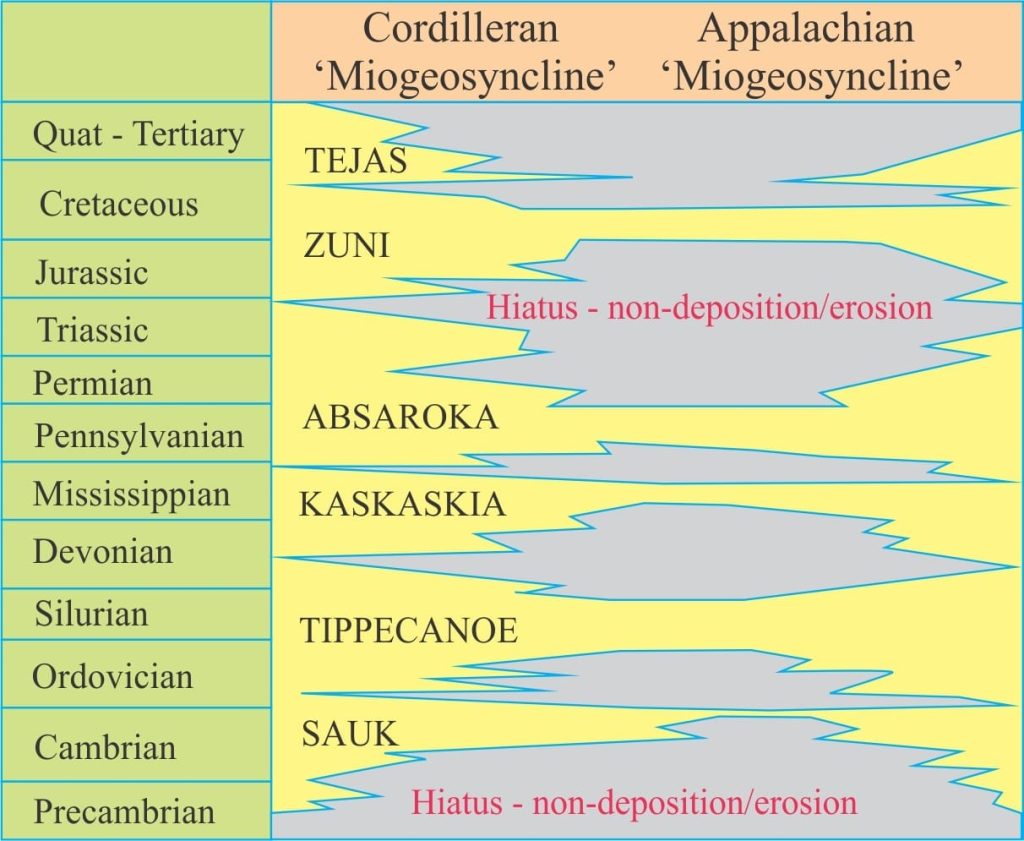
When Larry Sloss joined the faculty at Northwestern University in 1947, he became part of a geological powerhouse triumvirate with Edward Dapples and William Krumbein. It was here that Sloss’ ideas on rock assemblages and unconformities came to fruition, being impressed with Blackwelder’s earlier descriptions of unconformity-bound successions, and in 1949 he, with Krumbein and Dapples, first presented a stratigraphic framework that incorporated lithostratigraphic successions, or sequences, bound by unconformities. Part of their rationale was to provide a stratigraphic framework within which they could map sedimentary facies. The concept was applied to rock assemblages they had traced across continental USA. The audience of the day was skeptical, but the concept and the names they gave to each sequence are still used today (Sloss et al. 1963). They recognised that the amount of time missing at each unconformity varied fairly systematically from the western Cordillera to the Appalachians. The 6 sequences incorporate strata from late Precambrian to the present, each representing 10s of millions of years. For example, the time value of the Absaroka is about 117 million years.
Harry Wheeler (1907-1987)
Sloss et al. (1949) provided one of the first definitions of sequence as a stratigraphic entity, but restricted it to “assemblages of formations and groups … without specific time significance…” (quote from Pemberton et al. 2016). Harry Wheeler thought otherwise, and produced a definition that completely negated all lithostratigraphic connotations: his sequences contained assemblages of strata bound above and below by unconformities, that were independent of formal lithostratigraphic units (Wheeler, 1958) – a definition that basically pre-empted by 20 years, the foundations of sequence stratigraphy. This view of the stratigraphic world bordered on heresy to 1950s through 70s stratigraphers, for whom formations were the cornerstone of objective geological enquiry. Formations are based on composition and mappability; formation boundaries are essentially diachronous. Wheeler argued for the complete opposite. His proposal was one of the most important of the modern era, but was ignored for many years.
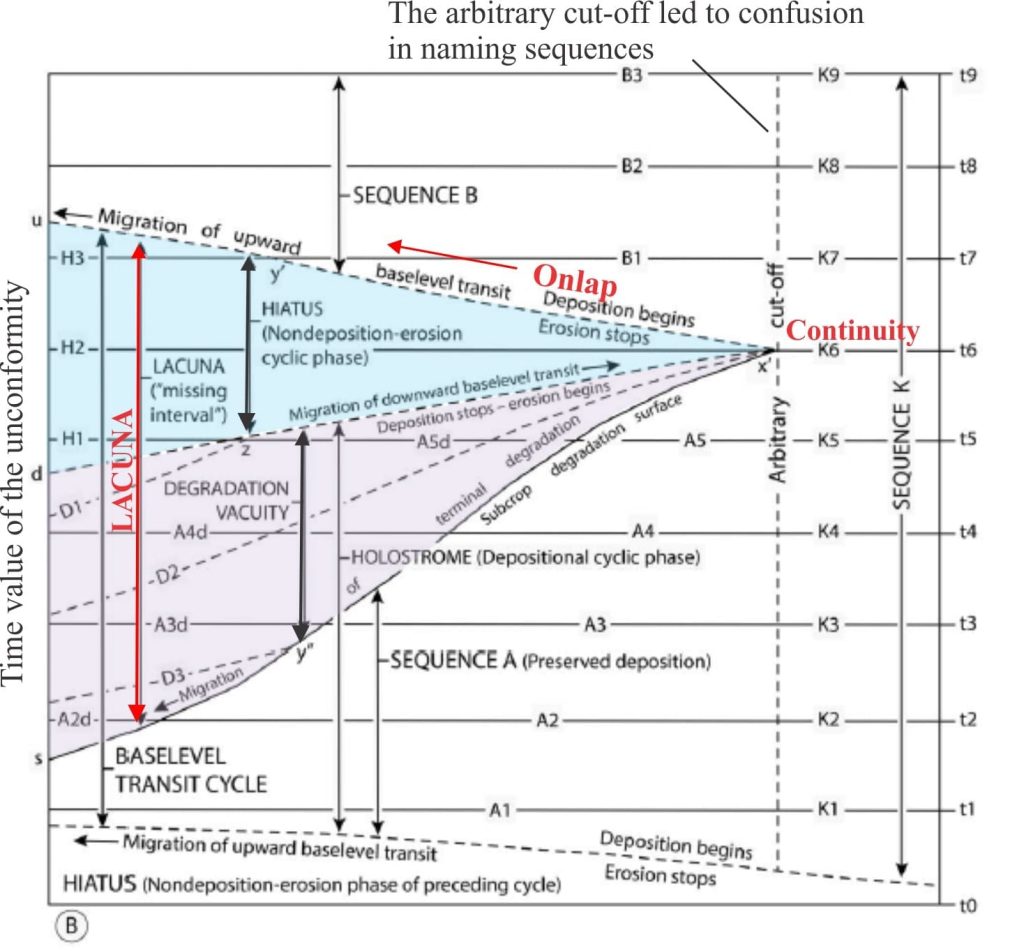
His explanation of sequences is best delivered by a figure published in 1964 where he introduces his own chronostratigraphic language. The Wheeler Diagram is a time-stratigraphic representation of two sequences, A and B, separated by an unconformity on the left, and a continuity on the right (he did not use the more recent expression correlative conformity, but that is what he meant). Timelines are indicated for each sequence. With one exception (discussed below) Figure 2a would not look amiss in any modern discussion on sequence stratigraphy where Sequence A shows a pattern of offlap, and Sequence B onlap.
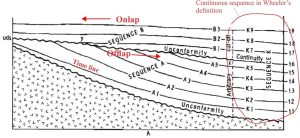
Figure 2b is a Time-Area (space) or chronostratigraphic plot of the stratigraphy in 2a. The Lacuna encompasses the total time missing at the unconformity, and is divided into an Hiatus (a term introduced by Grabau) which is a non-depositional or erosional episode above the unconformity, and an Erosional or Degradational vacuity below it (i.e. the time represented by rocks removed by erosion). Using Barrell’s terminology, he defined the line separating these two as the base-level transit that progresses from left to right (towards the continuity). The ‘onlap’ stage is defined by base-level transit to the left.
One important criticism of Wheeler’s scheme, in a sequence stratigraphic context, is the “arbitrary cut-off” between the unconformity and continuity (Bhattacharya and Abreu, 2016). For Wheeler, the cut-off separates a different sequence (sequence K in his Figure 2a). We now know that the assemblages below and above the continuity are an integral part of sequences A and B respectively.
Joseph R Curray
The 1960s were witness to burgeoning understanding of sedimentary facies, the dynamic controls on deposition, and changing sea levels (or base levels); in other words, a recognition that sediment deposition was a pretty complex process. In this context, Joseph Curray’s contributions centre on the processes of deposition versus non-deposition and erosion, as they relate to variable rates of sea level change (base level) and sedimentation. These ideas are nicely summarized in one of his diagrams, published in 1964.
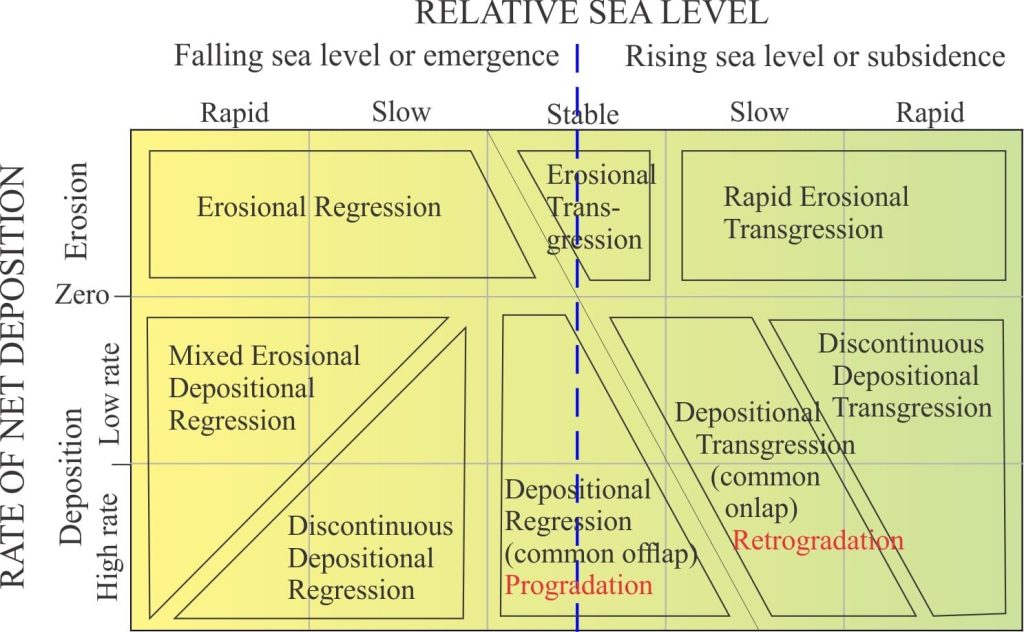
The diagram partitions regions of deposition or erosion depending on the interplay between base level and sedimentation. Although he did not discuss explicitly the concept of sediment accommodation space (a concept that is central to modern sequence stratigraphy), it is implicit in the diagram. Curray used the term relative sea level because he recognised the varying roles of eustasy, basin subsidence, tectonics, and sediment supply, and net deposition because of the competing roles of erosion and sedimentation.
David Frazier
Frazier worked extensively on Gulf Coast Cenozoic stratigraphy, including modern and ancient deposition on Mississippi Delta. He recognized a fundamental relationship between periods of deposition alternating with hiatuses; he referred to these cyclic alternations as depositional episodes. Each episode contains a succession of facies that represent specific styles of deposition associated with fluctuating sea levels (Frazier, 1974).
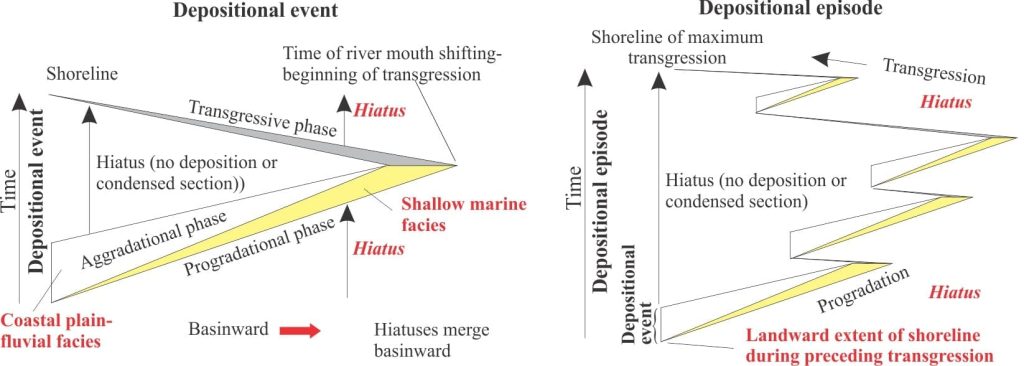
- Each episode begins with progradation of coastal facies and/or delta lobes during sea level stillstand, and at the same time,
- Aggradation of coastal plain and fluvial facies. The episode begins at the maximum landward extent of the shoreline from the preceding transgression. Aggradation decreases and progradation increases with time as sea level falls.
- During the transgressive, or terminal phase, sediment supply is reduced, and estuaries migrate up the earlier-formed river channels on the coastal plain. Seaward, on the adjacent shelf or delta platform, deposition is limited to fine-grained pelagic and hemipelagic sediment resulting in thin, condensed stratigraphic sections, or in the case of no sediment supply, an hiatus.
Depositional episodes may be punctuated by smaller scale cycles of regression-transgression (these are events in the Frazier diagram), but the overall pattern of sea level change is stillstand, followed by sea level fall, and transgression (or retrogradation) – much like Barrell’s 3rd order cycles superimposed on longer period 2nd order cycles. Frazier also notes that the point of maximum transgression (and the end of the episode) corresponds to an hiatal surface that is synchronous across the platform and slope.
Peter Vail, Robert Mitchum et al.
Peter Vail and Robert Mitchum continued to expand the ideas of Sloss (no surprise there really), Frazier and others. Their names and those of their colleagues at Exxon are basically synonymous with modern Sequence Stratigraphy. The rapid expansion of reflection seismic data coupled with extensive international drilling (and the accompanying wireline logs that also were developing rapidly), plus a burgeoning microfossil database, created an opportunity to develop the Sloss-Blackwelder-Wheeler ideas into a stratigraphic model that emphasized time, key stratigraphic surfaces such as unconformities, and depositional systems for which an understanding of depositional processes is key. AAPG Memoir 26 (1977) was devoted to papers on seismic stratigraphy and sequence stratigraphy by Vail and his Exxon colleagues.
The impetus for this conceptual revolution was the rapidly improving methods of acquiring and processing reflection seismic, developments tied inextricably with the hydrocarbon exploration industry. Seismic profiles allowed the identification of packages of strata, their geometry, stacking patterns, and lateral extent. This is where clinoforms came into their own, wherein reflections are considered to approximate timelines. In their original definition, a sequence is bound by unconformities and correlative conformities (what Wheeler called continuities), where relatively conformable packages of strata are bound by lap out surfaces: onlap, toplap, and downlap. Sequence bounding surfaces delineate important events across a basin.
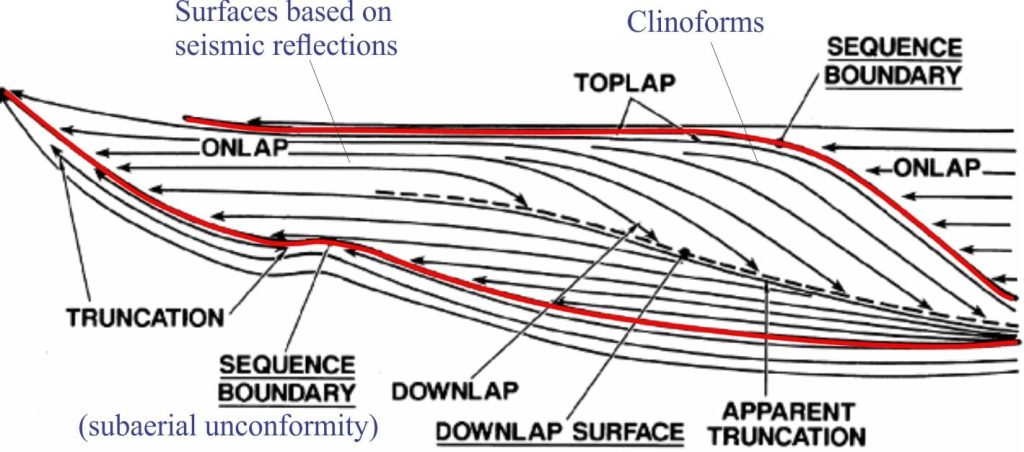
In their early analyses the Vail crew argued that eustasy was the primary driver of sea level fluctuations, and by correlating sequences they constructed a global sea level curve (note that the actual definition of sequences does not depend on this model). Not surprisingly this caused consternation in many quarters because our knowledge of sedimentary basin dynamics (subsidence profiles, tectonics, and the influence of sediment source area and climate) was also evolving rapidly. One outcome of the ensuing discussions, is that we generally refer to relative sea level, acknowledging that at any time it is the result of some combination of eustatic, subsidence and tectonic processes.
Other post in this series
A timeline of stratigraphic principles; 15th to 18th C
A timeline of stratigraphic principles; 19th C to 1950
Baselevel, Base-level, and Base level
Sediment accommodation and supply
Autogenic or allogenic dynamics in stratigraphy?
Stratigraphic cycles: What are they?
Sequence stratigraphic surfaces
Shorelines and shoreline trajectories
Stratigraphic trends and stacking patterns
Stratigraphic condensation – condensed sections
Depositional systems and systems tracts
Which sequence stratigraphic model is that?
References
J.P. Bhattacharya and V. Abreu, 2016. Wheeler’s confusion and the seismic revolution: How geophysics saved stratigraphy. Sedimentary Record (SEPM), June 2016, p. 4-11.
J.R. Curray, 1964. Transgressions and regressions. In, Miller, R.L. Ed. Papers in Marine Geology. Macmillan, p. 175-203.
D. Frazier, 1974. Depositional episodes: their relationship to the Quaternary stratigraphic framework in the northwestern portion of the Gulf Basin: Geologic Circular 74-1, Bureau of Economic Geology, The University of Texas at Austin, 28 p.
S. Patruno, W. Helland-Hansen, 2018. Clinoforms and clinoform systems: Review and dynamic classification scheme for shorelines, subaqueous deltas, shelf edges and continental margins. Earth-Science Reviews v. 185 p. 202–233. Available for download
S.G. Pemberton, J.P. Bhattacharya, J.A. MacEachern, and E.A.L. Pemberton. 2016. Harry Eugene Wheeler (1907-1987): A pioneer of sequence stratigraphy. Stratigraphy, v. 13, p. 95-112.
J.L. Rich, 1951. Three critical environments of deposition, and criteria for recognition of rocks deposited in each of them. Geological Society of America Bulletin v.62, p. 1-20.
L.L. Sloss, W.C. Krumbein, and E.C. Dapples, 1949. Integrated facies analysis. In, C.R. Longwell (Ed.), Sedimentary Facies in Geologic History, Geological Society of America Special Paper 39, p. 91-124.
L.L. Sloss, 1963. Sequences in the cratonic interior of North America. Geological Society of America Bulletin, v. 74, p.93-113.
P.R. Vail, R.M. Jr. Mitchum, and S. Thompson, III, 1977, Seismic stratigraphy and global changes of sea level, part 3: relative changes of sea level from coastal onlap; in C.E. Payton (ed.) Seismic Stratigraphy – Applications to Hydrocarbon Exploration: American Association of Petroleum Geologists Memoir 26, p. 63-81.
P.R. Vail, R. G. Todd, and J. B. Sangree, 1977 Seismic Stratigraphy and Global Changes of Sea Level: Part 5. Chronostratigraphic Significance of Seismic Reflections: Section 2. Application of Seismic Reflection Configuration to Stratigraphic Interpretation Memoir 26, Pages 99 – 116.
H.E. Wheeler, 1958. Time Stratigraphy, Bulletin of American Association of Petroleum Geologists: v 42, n. 5, p1047-1063.
H.E. Wheeler, 1964. Baselevel, Lithosphere Surface, and Time-Stratigraphy Geological Society of America Bulletin, July 1964, v. 75, no. 7, p. 599-610

















